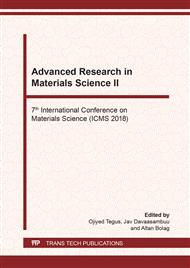p.17
p.27
p.37
p.44
p.51
p.59
p.65
p.71
p.79
Effect of Mechanical Activation of Fluidized Bed Fly Ash on Geopolymer Properties
Abstract:
This paper is focused on the elucidation of mechanical activation effect of circulating fluidized bed combustion fly ash (Amgalan Thermal Station, Mongolia) on mechanical properties of geopolymers. Fluidized bed fly ash was mechanically activated for 15-120 minutes with a vibratory mill. The effect of mechanical activation was quite visible on the particle size reduction and on the degree of amorphization.Geopolymer samples were prepared from the raw and milled fluidized bed fly ashes by alkaline activation. Chemical activation was performed with 10M sodium hydroxide solution, as well as solutions containing a mixture of sodium silicate and sodium hydroxide with a weight ratio of 2:1. The geopolymer cubic specimens were cured at 70°C for 24 hrs and their 7 days uniaxial compressive strength was measured. After curing and drying, the bulk density, water absorption and apparent porosity of geopolymer samples were evaluated.X-ray powder diffractometry (XRD), Fourier transform infrared spectroscopy (FTIR), scanning electron microscopy (SEM) and thermogravimetry-differential thermal analysis (TGA-DTA) have been used for the structural characterization of the CFA and the resulting geopolymers. The highest compressive strength of 32.4 MPa was achieved for the fly ash milled for 30 minutes and activated with the solution containing the sodium silicate and 10M sodium hydroxide at a weight ratio of 2:1. Non-milled CFA based geopolymers showed the compressive strength of 16.2 MPa after activation with the same solution. Mechanical activation resulted in an increase in the reactivity of the fluidized bed fly ash and that enhances the geopolymerization reactions.
Info:
Periodical:
Pages:
51-58
Citation:
Online since:
March 2019
Authors:
Price:
Сopyright:
© 2019 Trans Tech Publications Ltd. All Rights Reserved
Share:
Citation:


